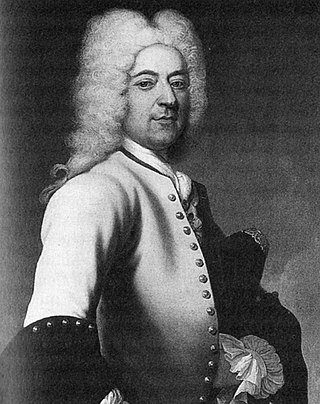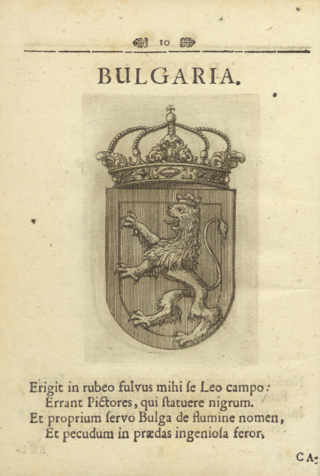Louis-Sauveur de Villeneuve (6 August 1675, Aix-en-Provence - 18 July 1745, Marseille) was French noble and diplomat. He was marquess of Forcalqueiret and baron of Sainte-Anastasie, who served as ambassador to the Ottoman Empire from 1728 to 1741.
During the Russo-Austro-Turkish War (1735–1739), Villeneuve was engaged in negotiations between warring parties, acting as a neutral mediator, but trying to secure an outcome that would be beneficial for French interests. Hoping to stop or reverse further expansion of the Russian Empire and the Habsburg Monarchy towards Ottoman territories, Villeneuve was hoping to achieve the status quo outcome in the Russo-Turkish conflict, and he also took advantage of unexpected Habsburg defeats in the final stages of the war, advocating for cession of several Habsburg regions to the Ottomans. He played prominent role in negotiations that took place in Belgrade and Niš, from August to October 1739. He persuaded Habsburg negotiator Wilhelm Reinhard von Neipperg to accept unfavorable preliminary agreement on 1 September, and acted as a co-signator of the final Treaty of Belgrade (18 September) that ended the Austro-Turkish war. Using mediating powers granted to him by the Russian government, Villeneuve also signed the preliminary Russo-Turkish agreement (also on 18 September, in Belgrade), and was instrumental in concluding the final Treaty of Niš (3 October) that ended the Russo-Turkish war. [1] [2] [3] [4]
During his service de Villeneuve made a point to learn more about the Ottoman madrasa system, the religious educational institution that had been operating in the Empire continuously since its establishment in 1330 by Orhan Gazi. Submitting the request to the Ottoman Foreign Ministry, de Villeneuve was presented with the Seven Stars curriculum (Kevakib-i Seb'a). This curriculum, of unknown authorship, expressed regrets that Islamic scholars had not made greater inroads into Christian countries where they were widely regarded as ignorant and superstitious. The Seven Stars curriculum presented to de Villeneuve aimed to overcome language barriers and improve the image of the Islamic world in the West. [5]

The Treaty of Passarowitz, or Treaty of Požarevac, was the peace treaty signed in Požarevac, a town that was in the Ottoman Empire but is now in Serbia, on 21 July 1718 between the Ottoman Empire and its adversaries, the Habsburg monarchy and the Republic of Venice.

The Treaty of Belgrade, also known as the Belgrade Peace, was the peace treaty signed on September 18, 1739 in Belgrade, Habsburg Kingdom of Serbia, by the Ottoman Empire on one side and the Habsburg monarchy on the other, that ended the Austro–Turkish War (1737–1739).

The Treaty of Niš was a peace treaty signed on 3 October 1739 in Niš, by the Ottoman Empire and Russian Empire, to end the Russo-Turkish War of 1735–1739. It was preceded by the preliminary Russo-Turkish peace treaty, signed trough French mediation on 18 September 1739 in Belgrade, while the peace arrangements were finalized bu the treaty of Niš on 3 October.

Charles VI was Holy Roman Emperor and ruler of the Austrian Habsburg monarchy from 1711 until his death, succeeding his elder brother, Joseph I. He unsuccessfully claimed the throne of Spain following the death of his relative, Charles II. In 1708, he married Elisabeth Christine of Brunswick-Wolfenbüttel, by whom he had his four children: Leopold Johann, Maria Theresa, Maria Anna, and Maria Amalia.

The Russo-Turkish War of 1735–1739 between Russia and the Ottoman Empire was caused by the Ottoman Empire's war with Persia and the continuing raids by the Crimean Tatars. The war also represented Russia's ongoing struggle for access to the Black Sea. In 1737, the Habsburg monarchy joined the war on Russia's side, known in historiography as the Austro-Turkish War of 1737–1739.

The Austro-Turkish War (1716–1718) was fought between Habsburg monarchy and the Ottoman Empire. The 1699 Treaty of Karlowitz was not an acceptable permanent agreement for the Ottoman Empire. Twelve years after Karlowitz, it began the long-term prospect of taking revenge for its defeat at the Battle of Vienna in 1683. First, the army of Turkish Grand Vizier Baltacı Mehmet defeated Peter the Great's Russian Army in the Russo-Turkish War (1710–1711). Then, during the Ottoman–Venetian War (1714–1718), Ottoman Grand Vizier Damat Ali reconquered the Morea from the Venetians. As the guarantor of the Treaty of Karlowitz, the Austrians threatened the Ottoman Empire, which caused it to declare war in April 1716.

The Banat of Temeswar or Banat of Temes was a Habsburg province that existed between 1718 and 1778. It was located in the present day region of Banat, which was named after this province. The province was abolished in 1778 and the following year it was incorporated into the Habsburg Kingdom of Hungary.

Ottoman Serbia refers to the Ottoman period in the history of Serbia. Various regions of medieval Serbia came under Ottoman rule already at the end of the 14th century, while the Serbian Despotate fell in 1459. Northern regions of what is now the Republic of Serbia were incorporated into the Ottoman Empire during later conquests, from 1521 to 1552. Since the Habsburg expansion towards those northern regions, in 1699 and 1718, Ottoman rule was gradually reduced to Serbian territories south of the Sava and Danube rivers (1739). From 1804 to 1830, the Principality of Serbia was gradually restored, as a vassal state of the Ottoman Empire. It gained independence in 1878, and expanded into southern regions, thus reducing Ottoman control to the historical region of the Old Serbia, that was liberated in 1912, thus ending Ottoman rule in Serbian lands.

Count Wilhelm Reinhard von Neipperg was an Austrian general.

The Kingdom of Serbia was a province (crownland) of the Habsburg monarchy from 1718 to 1739. It was formed from the territories to the south of the rivers Sava and Danube, corresponding to the Sanjak of Smederevo, conquered by the Habsburgs from the Ottoman Empire in 1717. It was abolished and returned to the Ottoman Empire in 1739.

The Battle of Grocka, also known as Battle of Krotzka, was the decisive battle of the Austro-Turkish War (1737–1739). It was fought between the Habsburg Monarchy and the Ottoman Empire on 21–22 July 1739 in Grocka, near Belgrade in the Habsburg-held Kingdom of Serbia. The Ottomans were victorious, and proceeded with the Siege of Belgrade, that led to the conclusion of the Treaty of Belgrade on 18 September 1739.

Koča's Frontier refers to the Serbian territory established in the Sanjak of Smederevo, Ottoman Empire, during the Austro-Turkish War of 1788–1791. The Habsburg-organized Serbian Free Corps, among whom Koča Anđelković was a prominent captain, initially held the central part of the sanjak, between February and September 7, 1791; after the Austrians entered the conflict the territory was expanded and became a Habsburg protectorate under military administration, called Serbia. After the Austrian withdrawal and Treaty of Sistova (1791), the territory was regained by the Ottomans.

Foreign relations exist between Austria and Serbia and their predecessor states. Austria has an embassy in Belgrade. Serbia has an embassy in Vienna and a general consulate in Salzburg. Austria is a European Union member and Serbia is a European Union candidate.

George Oliver Walsh, Count of Wallis was a field marshal of Irish descent in the service of the Holy Roman Empire and the Kingdom of the Two Sicilies and last regent of the Habsburg Kingdom of Serbia (1738–1739). Born into an exiled Irish family, he distinguished himself in Sicily by his capture of Messina. He then commanded on the Rhine (1733), then in Italy and Hungary. He lost the decisive Battle of Grocka against the Ottoman Empire in 1739, thus leading to the peace of Belgrade, which was unfavourable to Austria and thus led to his disgrace.
The territorial evolution of the Ottoman Empire spans seven centuries.

Johann Bernhard Stephan, Graf Pálffy de Erdőd was a Hungarian noble, Imperial Field marshal and Palatine of Hungary.

The capture of Belgrade was the recapture of Belgrade by the Ottoman Empire in 1739.

Habsburg-occupied Serbia refers to the period between 1686 and 1699 of the Great Turkish War, during which various regions of present-day Serbia were occupied by the Habsburg monarchy. In those regions, Habsburg authorities have established various forms of provisional military administration, including the newly organized Serbian Militia. By the Treaty of Karlowitz in 1699, some of those regions remained under the permanent Habsburg rule, while others were returned to the Ottoman Empire.

The Bulgarian National Awakening is the initial period of the Bulgarian National Revival in the history of Bulgaria, from the Treaty of Karlowitz to the Ottoman coups of 1807–08. During this historical period of enlightenment, the interest in self-identification and self-knowledge was aroused and revived in the conditions of the gradual decline of the Ottoman Empire, especially after the Treaty of Küçük Kaynarca.

The Battle of Orșova happened during the Austro-Turkish War of 1737–1739. The Ottomans defeated a relief Austrian force and captured Orșova in the end.